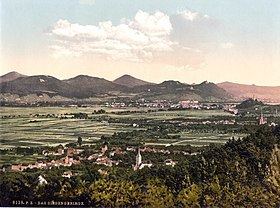Orogeny Volcanic Peak Großer Ölberg Age of rock Oligocene | Elevation 460 m Country Germany | |
 | ||
State/Province North Rhine-Westphalia and Rhineland-Palatinate Similar Drachenfels, Petersberg, Löwenburg, Großer Ölberg, Weilberg | ||
Seven Hills, or Seven Mountains (German: Siebengebirge), is a Central Uplandish hill range on the east bank of the Middle Rhine, southeast of Bonn, Germany.
Contents
- Map of Siebengebirge 53639 KC3B6nigswinter Germany
- Swr hin weg siebengebirge 02 12 2011
- Hills
- Origin of the German name
- References
Map of Siebengebirge, 53639 K%C3%B6nigswinter, Germany
The area, located in the municipalities of Bad Honnef and Königswinter, consists of more than 40 hills. The hills are of ancient volcanic origin and came into being between 28 and 15 million years ago. Much of the territory covered by Seven Hills belongs to the Seven Hills Nature Park (Naturpark Siebengebirge), which is under environmental protection.
The highest peak is the Ölberg at 460 metres above sea level. It is a popular tourist destination for hiking, because of its natural beauty.
Swr hin weg siebengebirge 02 12 2011
Hills
The seven most important hills:
Other hills:
Origin of the German name
Although the common English name "Seven Hills" is merely the most logical translation of the German name, Siebengebirge, the origins of the latter are disputed. Three theories exist:
- The oldest name (Moller, 1590) was not Siebengebirge, but Sieben Berge (septem montes, seven hills). Depending on the viewpoint near the river Rhine, one notices almost exactly seven hills, which are not always the same and not even the highest. Also, the number seven used to denote an arbitrary amount of items, was connected to magic and thus had a highly symbolic meaning. This makes it an obvious name for an area that was said to be sinister and impenetrable before the 19th century.
- The word sieben is derived from the word siefen, which denotes the wet valley of a stream.
- The name Siebengebirge emerged from the word Siedengebirge which indicated the presence of soap boilers ("Seifensieder"), who were banned from the valleys because boiling soap smelled so bad.
